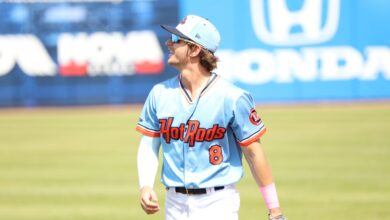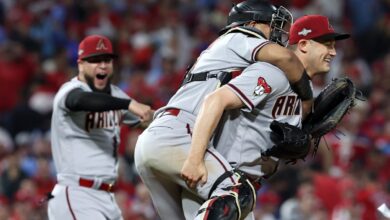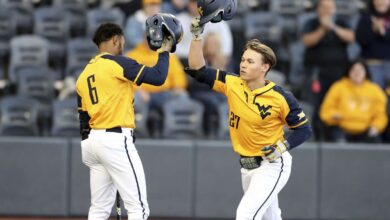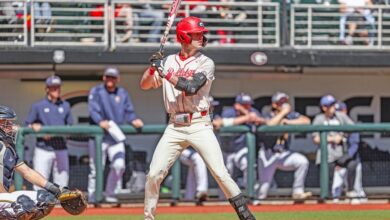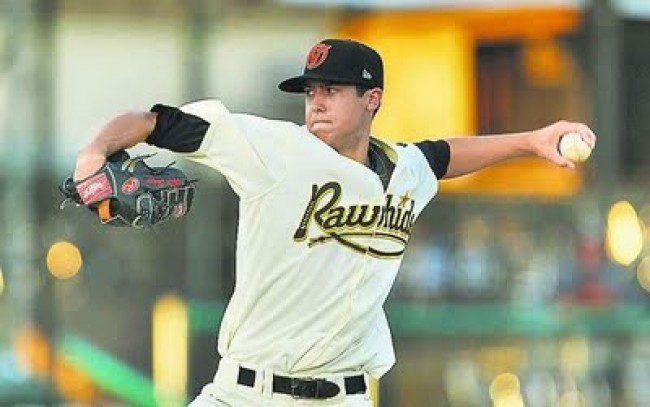

When the Arizona Diamondbacks won the World Series in 2001, they did it riding the coattails of two outstanding pitchers. Randy Johnson and Curt Schilling absolutely dominated the regular and post seasons that year, finishing 1-2 in the Cy Young, respectively. Johnson went 21-6 with a 2.49 ERA, 1.01 WHIP and 372 K over 249.2 innings, winning his third of four straight Cy Young awards. He followed that up by going 3-0 with a 1.04 ERA and 0.69 WHIP in the World Series, earning MVP honors. Schilling went 22-6 with a 2.98 ERA, 1.08 WHIP and 293 K over 256.2 innings during the regular season. He then went 4-0 with a 1.12 ERA, 0.64 WHIP, 56 K and 6 BB over six postseason starts. The aces combined for 43 of the team’s 92 wins (47 percent) and led them to their first and only title, over the Yankees, in maybe the best World Series ever, wining it in seven games.
They won 98 games the following year as the duo combined to go 47-12 with 651 strikeouts, finishing 1-2 again in the Cy Young voting; however, they were swept by the Cardinals 3-0 in the NLDS.
Ten years later, the Diamondbacks are once again doing it with pitching. This time around, however, they are more than a two-man show. And in a year or two, their depth in the rotation is going to give every other team in baseball fits.
After having the third-worst record in baseball last season at 65-97, the Diamondbacks had a 29-game turn around to finish 94-68 — sixth best in baseball — and took the NL West crown by eight games over the Giants, the defending champs.
Ian Kennedy, 26, led the charge this year by going 21-4 with a 2.88 ERA, 1.09 WHIP, 198 K and 55 BB, and he is a candidate for the Cy Young award. Originally drafted by the Yankees in the first round of the 2006 draft, he was involved in a three-team trade between the Tigers and Diamondbacks in 2009 that included sending Curtis Granderson from Detroit to New York. After three seasons, the Yankees gave up on him and their loss has been the Diamondbacks reward.
Daniel Hudson, a 24-year-old former fifth round pick of the White Sox in 2008, is another castoff who has made his former team look foolish in hindsight. Traded for Edwin Jackson, who was also part of the Kennedy trade, Hudson went 16-12 with a 3.49 ERA, 1.20 WHIP, 169 K and 50 BB this season after going 7-1 with a 1.69 ERA and 0.84 WHIP over 11 starts last season for Arizona.
Joe Saunders, the centerpiece of the trade that sent Dan Haren to the Angels, went 12-13 with a 3.69 ERA, 1.31 WHIP, 108 K and 67 BB this season. The 30-year-old left-hander is one of the best groundball pitchers in the game, thanks to his heavy sinker.
Josh Collmenter, a 25-year-old rookie, went 10-10 with a 3.38 ERA, 1.07 WHIP, 100 K and 28 BB, and he has some of the best control in the organization.
Both Kennedy and Saunders are eligible for arbitration this year, and Hudson and Collmenter are both still on their rookie contracts. Whichever route the Diamondbacks choose to take with the four, they have some outstanding prospects waiting for their turn in the rotation. Here’s what D-backs fans have to look forward to:
Tyler Skaggs — 6’-4”, LHP, age 20
Skaggs heads the list, and for good reason. A former 2009 first-round pick of the Angels, he was also part of the Dan Haren trade and may end up being the real centerpiece of the trade. He went 9-6 with a 2.96 ERA, 1.11 WHIP, 198 K and 49 BB over 158.1 innings for two leagues this season, was the youngest player ranked in the top-five in strikeouts and his 11.3K/9 was also among the best. He also got better as the competition did going 4-1 with 2.50 ERA, 1.04 WHIP, 73 K and 15 BB over 57.2 innings at double-A Mobile.
He comes armed with two plus/plus pitches. His mid-90s fastball has great late movement, and he uses it to intimidate opposing hitters, making them uncomfortable as possible before unleashing his devastating curveball, one of the best in the minors. Tall, strong-armed lefties are always a hot commodity and Skaggs should be a fan favorite the moment he gets to Chase Field.
Jarrod Parker — 6’-1”, RHP, 22
Parker was the team’s first-round draft pick (seventh overall) in the 2007 draft. He went 12-5 with a 3.44 ERA, 1.24 WHIP, 117 K and 33 BB in 117 innings as an 18-year-old during his 2008 debut. After posting a 0.95 ERA over four starts the following season, he got a promotion to double-A Mobile and seemed on the fast track to the majors. Then a strained elbow led to Tommy John surgery in October of 2009. Parker missed all of the 2010 season.
After an up and down season this year at Mobile, going 11-8 with a 3.79 ERA, 1.28 WHIP, 112 K and 55 BB over 130.2 innings, he got a call up to the majors to make his professional debut on September 7 against the Dodgers. He went 5.2 scoreless innings, allowing four hits. He also did some work out of the bullpen during the playoffs.
When healthy, Parker has electric stuff. His Frisbee slider is his best offering, and he uses it as his out pitch. It’s a wipe-out pitch with sharp, biting break. His fastball touches 97 mph and he has control of it both inside and out. His changeup is also a developing plus-pitch.
Trevor Bauer — 6’-1”, RHP, 20
Bauer was the team’s first of two top-10 picks in this year’s draft, taken third overall. His unorthodox, long-stride delivery reminds many of Tim Lincecum. He had one of the most dominant seasons ever by a pitcher at UCLA going 13-2 with a 1.25 ERA, 0.79 WHIP, 203 K and 36 BB over 137 innings. He uses a five-pitch mix to baffle hitters and keep them off balanced. His fastball hits 96 mph with movement, his 12-6 curveball is outstanding and his changeup rates as plus. He will also throw in a slider and splitter, mostly as a show-me pitch, though. Over 25.2 minor-league innings this season, he struck out 43 batters, good for a 15.1 K/9 ratio.
Patrick Corbin — 6’-3”, LHP, 22
Corbin was a second-round selection by the Angels in 2009 and was also part of the Haren trade. He went 9-8 with a 4.21 ERA, 1.32 WHIP, 142 K and 40 BB over 160.1 innings for Mobile this year, and he compares to fellow teammate Joe Saunders because of his ability to induce groundouts. His fastball can hit 91 mph with sinking, tailing action and his off-speed pitch is a hard slurve.
Wade Miley — 6’-1”, LHP, 24
The team’s first-round pick (43rd overall) in 2008, Miley has a five-pitch arsenal with his fastabll and slider being the best of the bunch. The fastball can hit 96 mph and the slider misses bats with late bite. His changeup is a developing plus-pitch while his curve and splitter are just show-me pitches. After going 8-3 with a 4.30 ERA, 1.32 WHIP, 102 K and 44 BB over 129.2 innings in the minors this year, he got a promotion to the show. Over seven starts, he went 4-2 with a 4.50 ERA, 1.65 WHIP, 25 K and 18 BB over 40 innings, showing he may need more time to adjust to big-league pitching.
A pair of corner infielders at class-A Visalia enjoyed stellar seasons, as well. Twenty-year-old Bobby Borchering, the team’s first-round pick in 2009 (16th overall) hit .267/24 HR/92 RBI over 135 games. The switch-hitter plays both first and third base. Another first-round pick in 2009 (35th overall), 20-year-old Matt Davidson, hit .277/20 HR/106 RBI over 135 games while playing mostly at third. Both will probably make a move to the outfield as their defense, and Goldschmidt, will prevent a stay at their current positions.
Ryan Wheeler, the team’s fifth-round pick in 2009, looks to be the third baseman of the future. He hit .294/16 HR/89 RBI over 131 games at double-A Mobile this season. The 23-year-old left-hander is currently playing at the Arizona Fall League, where he is hitting .349/6 2B/6 RBI over 10 games.
With Justin Upton, Miguel Montero and Goldschmidt taking care of the offense, and the stockpile of young pitching, the future looks very bright for Diamondback fans.


